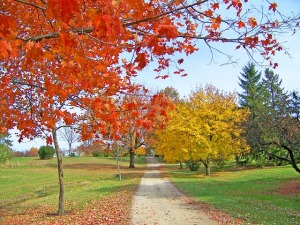 Have you been wondering when the ideal time is to plant trees and shrubs in Tulsa? Actually, fall is a great time to plant these gorgeous landscape additions. Shrubs and trees can really bring a great deal of structure and character to your Tulsa landscape design. Planted in a row, they can help add privacy to your outdoor living space and home and reduce noise. And, of course, they can provide shade during those hot summer months. They can also be used to reduce energy costs inside your Tulsa home by implementing smart tree placement, as well as other green technologies such as green roofs and walls.
Have you been wondering when the ideal time is to plant trees and shrubs in Tulsa? Actually, fall is a great time to plant these gorgeous landscape additions. Shrubs and trees can really bring a great deal of structure and character to your Tulsa landscape design. Planted in a row, they can help add privacy to your outdoor living space and home and reduce noise. And, of course, they can provide shade during those hot summer months. They can also be used to reduce energy costs inside your Tulsa home by implementing smart tree placement, as well as other green technologies such as green roofs and walls."If placed strategically, trees can reduce summertime cooling energy needs by 7-47 percent and wintertime heating needs by 2-8 percent,” the American Society of Landscape Architects reported.
Planting shrubs and trees in the fall, as the weather is getting cooler, will allow the plant's root systems to grow and develop before winter sets in and before the next summer's heat. Although the air temperature is getting cooler, the soil is still warm enough to help encourage root growth. Sometimes less watering is needed with wetter and cooler fall weather. With a stronger root system established, shrubs and trees will be better able to deal the drought and heat of summer. However, be careful to not plant too late in the season when the ground is freezing because this, of course, could be damaging to the tree.
 Fall is also a good time to plant trees because this is usually when they go into dormancy. When they are dormant, handling and moving them is easier on the tree. Choosing trees in the fall will help you see the different color possibilities for your landscape in the fall when the leaves change.
Fall is also a good time to plant trees because this is usually when they go into dormancy. When they are dormant, handling and moving them is easier on the tree. Choosing trees in the fall will help you see the different color possibilities for your landscape in the fall when the leaves change.When choosing shrubs and trees to plant in your landscape, look for species native to your area. Native trees and shrubs will be more resistant to drought and disease and will require less maintenance. Because these plants are already adjusted to the climate, they will also usually need less water.
Before planting, research the tree or shrub’s growing height when it’s mature so you know how far away to plant it from other structures, plants, and trees. Remember to plant the tree far enough away from houses, power lines, and other structures so that the mature foliage or roots do not interfere with any of these buildings or utilities. Planting them too close to these areas could pose a fire hazard.
Before you dig, check with your local utility companies to see if there are any underground utility lines in your yard. Trees, themselves, should also not be planted too close together so that they do not have to compete for sunlight or their root systems do not crowd each other.
Trees and shrubs not only increase the beauty of your landscape, but can also increase your property’s value and curb appeal. The horticulturists and landscape designers at Tulsa’s Oklahoma Landscape can help you choose and plant the best trees and shrubs for your landscape as well as develop a custom care program for your landscape.

No comments:
Post a Comment